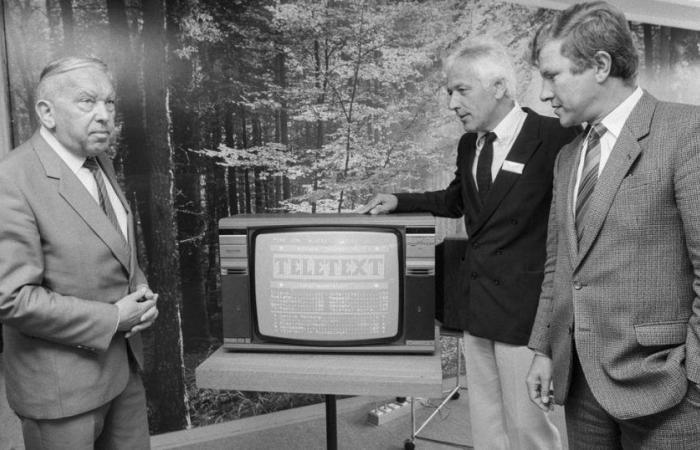Everyone says it’s getting old with its outdated characters and technology from another era, but teletext is alive and well at 40 years old. And it still has many loyal users, who know its numbers by heart and eagerly await the latest sports or voting results.
On July 3, 1984, SSR Director General Leo Schürmann presented a revolutionary new information system in Switzerland: teletext, with its short articles with yellow titles and blue-white-blue text, its numbered summaries, its Swiss, international or sports news, its weather, its radio-TV programs and many other services.
At this time, the beginnings of the new technologies that are currently overwhelming society can be seen: Macintosh launches the first personal computer with a mouse, while the first commercial mobile phone is produced by Motorola. It is also the advent of the CD-ROM, the Discman and the game Tetris.
Without taking offense at this competition, teletext took its place in homes in German-speaking Switzerland in 1984, the following year in French-speaking Switzerland and in Italian-speaking Switzerland in 1986, the SSR noted in a press release on Tuesday. Because this is also the strength of this new media: editorial offices in the three national languages and content as close as possible to the three linguistic regions.
A success for 40 years
The Swiss population quickly adopted teletext, appreciating its simplicity, efficiency and rigour, in particular the art of reducing long pieces of information to very short texts and the possibility of having access to the results of sporting events or votes very quickly.
Everyone quickly knows on which page to find the winner of the latest ski race, the latest news or the weather forecast for the next day. And hockey or football fans use the colours of teletext in their everyday language: being in green means qualifying and being in red means a bad result. And for 40 years, it has not been uncommon to see politicians scrutinising the pages of teletext to find out the verdicts of the ballot boxes.
Some people today consider that teletext is old-fashioned and at the end of its life. A few years ago, a blogger had even called it “the cave art of the digital age” or “the nostalgic antithesis of all the chic, trendy filters we are exposed to today” and wondered how it could survive.
But in fact, at present, 2.5 million people consult it occasionally and 1.6 million at least once a week. In terms of usage, teletext is thus ahead of LinkedIn, Tiktok or X. And when, in 2021, the IGEM Digimonitor figures on media usage were published and it was possible to read that Instagram was overtaking teletext for the first time, many young people wondered what this unknown medium could be.
>> Read also: Instagram dethrones Facebook for the first time in Switzerland
What is teletext?
But how does teletext actually work? It is an information transmission system developed to broadcast text information via TV signals, explains the SSR. Initially, a teletext decoder integrated into the television read the transmitted data and displayed it on the screen when the user activated the mode provided for this purpose.
With the introduction of digital television, the service was also digitized, the image quality improved and the response time shortened. Today, information is transmitted to digital televisions via an additional data stream.
Its now cult pixelated layout, in its original 80s look, in eight colours with its 25 lines of 40 characters per page and 800 pages maximum, has survived until now.
Since 2009, teletext has also been available as an application or online, via teletext.chThe most popular pages are 180 (sports), 500 (weather), 700 (radio-TV program), 104 (Switzerland) and 100 (home page with news briefs).
Teletext is also a very popular tool for people with sensory disabilities: from page 770, they can set the subtitles for TV programmes.
>> Review the explanations in 2011 by Nicolas Roulin, editor-in-chief of teletext, on how the system works:
boi






